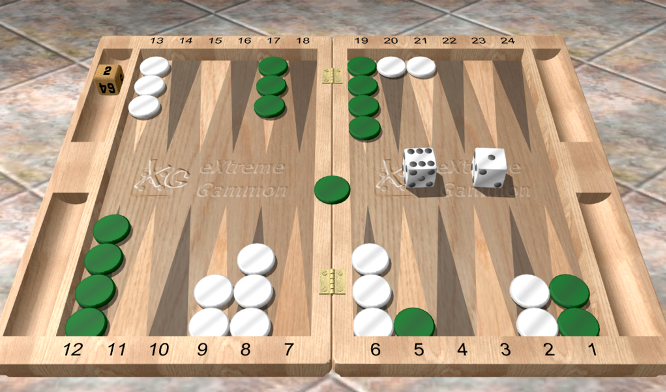What’s Your Game Plan?
Dan Rovira
If you haven’t read Masterclass already, you probably should have. The main reason is that it is one of the only backgammon books that focuses on game plan. Take this position below for example. How would you play a 61?
Here you have a number of options that look enticing. White is leading by 49 pips before the roll, so when ahead race with 20/13, right? WRONG. What else is there? We can make the bar-point. That looks good because we would then have a four-prime and box-in green’s back anchor. NOPE.
The correct play here is 13/7 6/5*. Let’s think about this position to understand why. Firstly, green already has a checker on the bar so let’s put another one up there, and vastly reduce green’s entering rolls: only 16 rolls would enter both after the second hit, as compared to 32 with only one on the bar.
Also, what happens if we don’t hit? Well, we’re effectively giving green a free roll to make our 5pt which would be a permanent asset for her but a big nuisance for us as we try to bring our checkers home safely.
Now let’s look at white’s home board. Here you can see that white has made a deep point – the 2pt. This means white has a blitz structure. If a higher point had been made such as the 5pt or 4pt, then it would be a prime structure. If we can determine from which points we have made which game plan we should be following, then that will help us find the right answer. A blitz structure means ATTACK.
Another important indicator of whether to blitz or not is how many checkers white has in the zone ready to attack. Sometimes in commentary you will hear it referred to as wood or ammunition. Here you can see that white has 10 checkers from his two- to his nine-point. That’s enough to blitz. Here’s a simple rule of thumb to remember when facing these positions:
8 or fewer checkers – no blitz
9 checkers – consider blitzing
10 or more checkers – blitz!
Even with the cube centred, this move is still right because of the above reasons. Now, it’s your turn.
This is slightly later in the game and white has rolled another 61. How do you play it? I’ll give you a moment to think about it, but remember to consider the WHY of the play as well as the WHAT.
The best way to find the right play is to go through all the candidate plays and evaluate them against one another. You’ll then be able to rule out the plays that don’t feel right, or – with better knowledge – that you understand to be wrong from looking at aspects of the position.
What are our options? We could run 21/15 to safety the blot and then look for a good ace? We could make the five-prime? Or we could play super safe with 15/9 7/6? Anything else?
The correct play is 9/3* 7/6. Why is this? Before looking at my explanation, try to articulate why you think this move is correct yourself…
These are the reasons: 1) White has the deep 2pt point made and therefore has a blitz structure, 2) White now has 11 checkers in the zone which makes this a stronger blitz than the previous position, 3) We do not want green to make the second anchor in our home board and have a reasonably timed back game, 4) Anything else is too passive and doesn’t follow the game plan.
Finally, what’s the deal with 7/6? Well, this ace avoids the nasty 33 joker where you’d get hit twice! Well done if you recognised this also. Even when playing a blitz, be mindful of turnaround rolls. Move every checker with thought and purpose!
Dan Rovira has the UK’s leading YouTube backgammon learning channel at @BackgammonIsBeautiful


